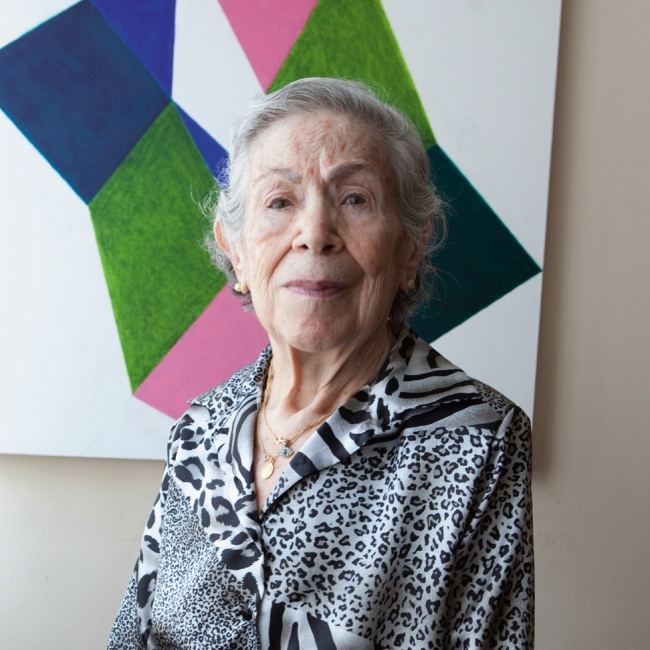Galerías y otras organizaciones que le representan
Descripción del Artista
N.H. Nació en Berlín, Alemania, en 1928, argentina por opción, es cineasta, con una larga trayectoria en cine experimental. En la década del 60 y 70 expandió su actividad en forma de instalaciones, objetos, performances, grafittis, intervenciones urbanas.
En sus obras expone temas centrales como el amor, el nacimiento y la muerte, o interrogantes sobre la condición femenina, recreados a través de un lenguaje de imágenes particularmente íntimo, con una marcada poesía visual y sonora. Hasta el momento tiene realizadas más de 30 películas en súper 8, en 16 mm y video. En las que figuran largometrajes, cortos, y documentales.
Entre los títulos más destacados se encuentran: Come out, Marabunta, A-dios, Taller, Ama-zona, Bebes, Mujeres, Homecoming, Pioneros, Ana donde estás, La pasión, Testamento y Vida interior, El aleph , Rumi y El mito de Narciso. Dentro de su obra escrita ha publicado los libros La pasión según San Juan, el olvido del ser (libro de ensayos realizado conjuntamente con el filósofo Luis Jalfen) y Aigokeros (ensayos).
Bio (English)
Daughter of Heinrich Heuser, an Expressionist painter, and great- granddaughter of Narcisa Perez Millán, who was born in Argentina, Narcisa Hirsch was born in Berlin in 1928.
N.H. came to Buenos Aires in the early thirties in what was intended to be a visit, but she was forced to stay due to the war in Europe. In 1950, she married Paul Hirsch, a German Jew from the city of Frankfurt who had immigrated to Bolivia. They had three children.
Her early work—like that of her father—was mostly in the media of painting and drawing, though she also made prints and wood engravings.
In the fifties and sixties, avant-garde artistic tendencies emerged in Buenos Aires. Venues like the Instituto de Arte Moderno, founded by Marcelo De Ridder in 1949, the Instituto Torcuato Di Tella, and the Lirolay Gallery, where N.H. held various shows of paintings and objects, appeared.
At that time, influential art critic Jorge Romero Brest, the director of the Instituto Di Tella, had declared traditional easel painting dead.
Influenced by these ideas and others related to performance, living theater, and non-traditional art venues that were emerging mostly in the United States at the time, N.H. took her art to the street with what were, at that time, called “happenings.” Works along these lines include Manzanas [Apples], Bebés [Babies] and, in 1967, La Marabunta.
It was at that time, first by filming the creative process that led to La Marabunta and then the performance of that work presented at Coliseo Theater in conjunction with the premiere of Antonioni’s Blow Up, that N.H. began making films. La Marabunta itself entailed a giant skeleton with pigeons and parrots inside covered with food.
From the outset, her work in film was experimental in the spirit of Buñuel and Dalí in Spain in the thirties and Hans Richter and many other Bauhaus artists in Germany.
After having been abruptly interrupted by World War II, experimental cinema re-surfaced with great power in the United States, mainly New York, in the fifties and sixties. At the forefront of that movement was Jonas Mekas.
N.H began filming in 16mm and later produced work in Super 8, which, because inexpensive, allowed anyone to make non- commercial film.
N.H. formed part of a group of filmmakers that took shape spontaneously. These artists would get together to screen their films in venues that were neither theaters nor institutions—with the exception of the Goethe Institute, which supported this movement for a time and gave it a degree of formality.
This small group of filmmakers included Marie Louise Alemann, Claudio Caldini, Horacio Vallereggio, Juan Villola, and Juan José Mugni, whose work flourished in the seventies and eighties, the years during which N.H made most of her films, among them: Come Out, Taller [Studio], A-Zona, Testamento y Vida Interior [Testament and Inner Life], Homecoming, A-Dios, La Pasión [The Passion], Ana donde estás? [Ana, Where Are You?] Rumi, El Aleph [The Aleph], and El Mito de Narciso [The Myth of Narcissus], an autobiography in images.
In addition to her purely experimental films, N.H. produced and continues to produce installations such as El Silencio [Silence] and Predicando en el Desierto [Preaching in the Desert], an installation in progress in Patagonia. Both of those works were collaborative efforts with Enrique Banfi. The work El Grito [The Scream] was produced in conjunction with Jorge Caterbetti.
When Super 8 was no longer available on the market due to the advent of video, N.H. wrote and published three books:
La Pasión, El Silencio, and Aigokeros, a book of essays with haiku written in Spanish and translated into Japanese.
Regarding film, N.H. states:
“Experimental or underground film is often considered enigmatic because its language, like that of poetry, requires open perception, almost ingenuousness, on the part of the viewer who generally ‘fears’ that, because so unexpected, images may become threatening.”

Actualidad, 25 nov de 2020
Por ARTEINFORMADO
Para el Museo Reina Sofia es el momento de rescatar de la sombra el nombre de la cineasta argentina Narcisa Hirsch. El artista brasileño Maxwell Alexandre es uno de los ...

Mercado, 05 jun de 2018
12 artistas latinoamericanas fundamentales rozando y superando el siglo
Por GUSTAVO PéREZ DIEZ
Todas ellas son ejemplos de perseverancia y constancia, a las que nadie les ha regalado nada. Lo conseguido, a lo largo de más de cinco décadas de trayectoria, ha sido ...

Exposición. 11 abr de 2025 - 28 sep de 2025 / Museo Guggenheim Bilbao / Bilbao, Vizcaya, España

Formación. 08 may de 2025 - 17 may de 2025 / Museo Nacional Centro de Arte Reina Sofía (MNCARS) / Madrid, España